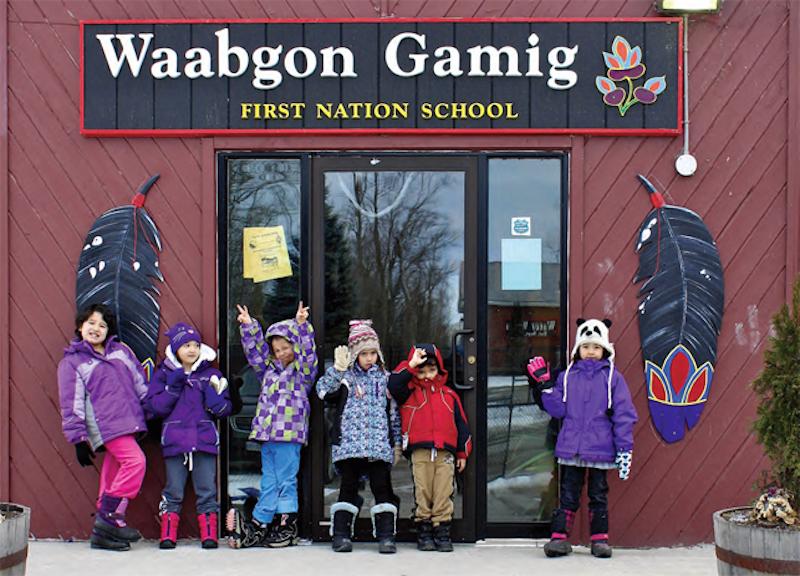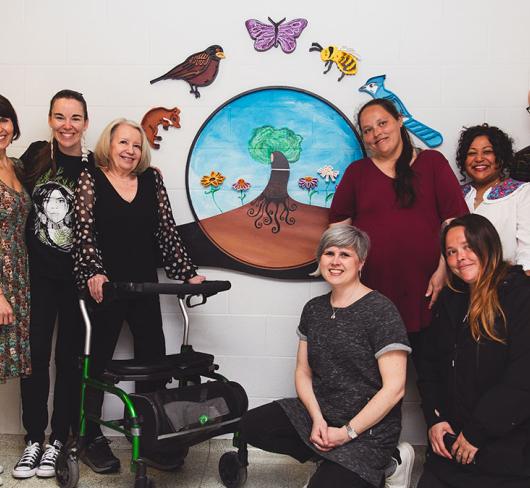
Waabgon Gamig: Excellence in Early Childhood Education and Teaching on Georgina Island First Nation
Four years ago, the Georgina Island Indian Day School, located within the York Region District School Board, officially became the Waabgon Gamig First Nation School. Waabgon Gamig means “Blossoming House,” and the school has indeed seen the majority of its students blossom. Outstanding student life, multi-literacy approaches, collective and cultural norms, professional practice, and a special program called the Junior Kindergarten Transition Program could be the reasons behind the success realized by the students in this tiny First Nation.
The little red two-room schoolhouse is located on the main road of Georgina Island, which is in the middle of Lake Simcoe and accessible only by ferry, airboat, or ice road. The school is joined to the public library, which makes it a centre of community life. It employs two teachers (seconded from York Region District Board), a team leader, a child and youth worker, an educational assistant, a Native-language teacher and a part-time secretary.
Georgina Island has a population of approximately 250 residents, and was established by the federal government in the late 1800s. There are 23 students in the entire school, which houses two multigrade classrooms: the first a grade SK-2 and the second a grade 3-5. Just a few metres down the road from the school is the Niigaan Naabiwag Child Care Centre. This is where many students begin their developmental journey, ending up in the full-day, every-day senior kindergarten early learning program.
The daycare and the kindergarten classrooms are two places where the educational magic happens. For the past four years, students in the Junior Kindergarten Transition Program have achieved so much, both socially and academically.
On Monday morning, the students of Waabgon Gamig First Nation School begin their week together in a circle. A smudge bowl burning sage and an eagle feather set the tone for the day, clearing any negative energy. Students hear the daily announcements and sing “O Canada” in English, French, or Ojibwe. Then they make their way to their classrooms, where the emphasis is on building a community of respectful learners. Having cultural content embedded within the curriculum allows students to see a reflection of their identity, one they can be proud of. Their pride of heritage is apparent in the hand-drumming songs, hoop-dancing teachings, Traditional Arts and Ecological Knowledge program, and perhaps most importantly the Native Language program, which begins at the child care centre and continues into high school and university studies. The mother tongue of the Chippewas of Georgina Island is Anishnaabemowin, the Ojibwe language.
The motto for learning is “Raise the expectations, and they will succeed.” Students have access to technology, highly trained teachers, individualized programs, and experience a calm and warm approach to learning and behaviour expectations. Because First Nations students on reserves in Canada receive an amount that is only half of the provincial standard, the education manager must find additional funding and resources to enhance the learning environment.
Technology, culture, and best practices are also supported through initiatives highlighted in the First Nation Student Success Program (FNSSP). This is a three-year program funded by Aboriginal and Northern Affairs Canada in 2010. The band education manager and the FNSSP team leader are responsible for collecting data that tracks student progress.
While this data, coupled with teacher observation and evaluation, does inform teaching practice, Waabgon Gamig has a strategy that involves much more. Waabgon Gamig staff have invested time and resources into quality early literacy resources, considerable amounts of professional development, and flexible scheduling that meets students’ needs. They have also benefited from training opportunities such as ETFO’s Aboriginal Women in Education Bursaries and the Dreamcatcher Fund, sponsored by Grand River Enterprises Six Nations Limited. The latter fund assisted the school’s kindergarten teacher to attend the Harvard University Summer Learning Institute for two summers.
All of these supports have contributed to the ultimate success of students, especially kindergarten students. So how does it all begin?
The Junior Kindergarten Transition Program
The Junior Kindergarten Transition Program was developed by York Early Years, the Niigaan Naabiwag Child Care Centre, and school staff after numerous attempts at a balanced kindergarten program. The ultimate program goals are intended to provide students with a seamless transition from daycare to school, and to provide them with social and academic learning skills that prepare them for a fantastic educational career.
Initially, students in the Junior Kindergarten Transition Program are at the daycare for the full day. In the first term, the Waabgon Gamig kindergarten teacher visits weekly, and the students receive daily focused literacy and numeracy instruction from early childhood educators. After a few months, students begin to go to the school weekly, visiting the classroom, lunchroom, and library. Students transition into the classroom by engaging in learning through play centres, listening to stories read to them by their peers who are already reading, and engaging in small-group critical literacy lessons with the kindergarten teacher. Often the early childhood educator stays in the classroom to ensure children continue to feel comfortable in their new learning environment. In the third term, students are dropped off at the school in the morning by the daycare staff for the literacy and numeracy block and lunch. They later return and continue programming at the child care centre. In June, parents are transitioned into kindergarten routines, being asked to drop their children off at the school once a week. In August, students graduate from daycare to senior kindergarten, and a community celebration is held. September sees the children attending senior kindergarten all day, every day at the school.
The ECE staff and the teacher have time to plan together. They share information about students and ideas about engaging parents and arranging field trips that enhance the learning experience. Along with a host of strategies that involve parents such as “lunch and learns,” literacy dinner nights, and welcome sessions, teachers also invite parents on field trips and to school assemblies. With these strategies, Waabgon Gamig has noticed a significant increase in parental participation.
These strategies are also influential in creating a common language for literacy and learning that is shared by the home, daycare, and school. This means that the language used in teaching children how to read or how to print numbers is consistent and creates a solid and familiar foundation for learning.
Here’s an example: Imagine you are four years old and learning how to print letters in the alphabet. You are at home, and your mom says to you, let’s print the letter A: “Start at the bottom, make an upside down V, with a stick in the middle.” You go to daycare, and your teacher says, “Let’s print the letter A. Start at the top, make a stick slanted down this way, and a stick slanted down this way, and put a stick through the middle.” When you get to school, your teacher says, “Let’s print the letter A.” She sings a song, does an action, and then tells you, “All letters, including A, can be made with four simple lines; Big curve, little curve, big line, and little line. To make an A, you start at the top, draw a big line down, go back to the top, draw a big line down, and draw a little line in the middle.”
Confused yet? This is why Waabgon Gamig’s kindergarten teacher and early childhood educators have taken significant training to ensure their students, parents, family members, and staff have a common language on printing letters, making letter sounds, reading and writing skills, employing math strategies, and asking questions of the children that promote critical thinking.
The proof of success is evident in many disciplines, but perhaps most in the literacy results.
Ultimately, Waabgon Gamig shares a common goal with educators across the globe: student success. The staff also hopes that other daycare providers, early childhood educators, parents, and kindergarten teachers have the opportunity to build relationships to develop a shared approach. The success of this program is a result of trial and error, constant revision, positive feedback, and continued support. On October 5, 2011, World Teachers’ Day, this program and the staff received both a Prime Minister’s Award for Teaching Excellence and a Prime Minister’s Award for Excellence in Early Childhood Education. What an exciting and rewarding way to begin another year, and what a milestone for an “Indian Day School.”
For further information, including a detailed view and long-range plans of the Junior Kindergarten Transition Program, visit the Waabgon First Nation School website or contact the kindergarten teacher directly at www.waabgongamig.ca. You can also view the program video at the following links:
Part 1: www.youtube.com/watch?v=E2iUcnvp0sU;
Part 2: www.youtube.com/watch?v=dZ-K5h_oFME.

